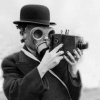Not being up with what they used on those geared props I dont know if it was simple or hard to make it run in reverse. On the grand scale of things making a simple engine run backwards is not that hard, pumps etc are very simple, like wise starters etc. But some of those complex radials are a no way!
But counter wise screws does make a lot of sense from a stability factor.
What do they do on modern twin engined planes?
As I wrote, there are a lot of components that would have to be redesigned to run backwards. I didn't say it was difficult, but that it doubles the parts inventory and therefore adds expence and problems in time of war. What I didn't even begin to comment on was such details as changing from righthand to lefthand threads for some critically important nuts to still be self-tightening, oil return scrolls redesigned to not pump oil overboard, lefthanded tachometer drive or instrument and much more.
The prop reduction on the V1710, as with most in-line engines, was a simple pair of spur gears so the prop and engine rotate in opposite directions. It is a straightforward bit of redesign to add an idler pinion to get the prop rotating in the same direction as the engine.
Here's a cutaway from page 233 of the cutaway thread:

There are very few modern twin-propellor aeroplanes and those that there are are not in the same power/weight league as these aeroplanes so I doubt they bother with contra-rotation. Since most have gas turbine engines it would certainly be done by gearing, if at all - even the non-technical must see that a gas turbine cannot easily be made to run backwards.
No idea if this is true or not, but I was once told by an ex-pilot, that on the Allisons used in the P-38, reversing the engine didn't require much more than a change of firing order. That can't be right can it?
ETA no of course it's wrong. Just consider what you'd have to do to a single cylinder four-stroke engine to get reverse rotation, before you think of ancilliaries, etc that I've been banging on about
Edited by Allan Lupton, 13 August 2012 - 07:53.





























